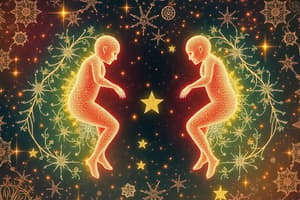Podcast
Questions and Answers
The process that increases genetic diversity within a population is:
The process that increases genetic diversity within a population is:
- asexual reproduction
- sexual reproduction (correct)
- binary fission
- cell division
Haploid cells are formed during:
Haploid cells are formed during:
- occurs in meiosis (correct)
- neither mitosis or meiosis
- occurs in mitosis
- both mitosis and meiosis
An increase in the number of chromosomes from generation to generation is:
An increase in the number of chromosomes from generation to generation is:
- both mitosis and meiosis
- neither mitosis or meiosis (correct)
- occurs in mitosis
- occurs in meiosis
Each chromosome doubles itself during:
Each chromosome doubles itself during:
Chromosomal/genetic duplication occurs during:
Chromosomal/genetic duplication occurs during:
Each daughter cell contains the same kind and number of chromosomes as the parent cell during:
Each daughter cell contains the same kind and number of chromosomes as the parent cell during:
The resulting cells could be sperm cells or egg cells during:
The resulting cells could be sperm cells or egg cells during:
Chromosome number triples during:
Chromosome number triples during:
Occurs in two stages:
Occurs in two stages:
The genetic material/chromosomes of the daughter cells are different than that of the parent cell during:
The genetic material/chromosomes of the daughter cells are different than that of the parent cell during:
Messenger RNA sequences are determined by grouping of three nucleotides called a:
Messenger RNA sequences are determined by grouping of three nucleotides called a:
The anticodon is found on:
The anticodon is found on:
The synthesis of a new double strand of DNA begins when the two strands of the original DNA double helix:
The synthesis of a new double strand of DNA begins when the two strands of the original DNA double helix:
Flashcards
Sexual Reproduction
Sexual Reproduction
The source of genetic variation in a population through the combination of genes from two parents.
Mitosis
Mitosis
Cell division that results in two identical daughter cells.
Meiosis
Meiosis
Cell division that results in four daughter cells each with half the number of chromosomes of the parent cell.
Haploid Cells
Haploid Cells
Signup and view all the flashcards
Chromosome Number Stability
Chromosome Number Stability
Signup and view all the flashcards
Chromosome Duplication
Chromosome Duplication
Signup and view all the flashcards
Daughter Cell Genetic Similarity
Daughter Cell Genetic Similarity
Signup and view all the flashcards
Sperm and Egg cell production
Sperm and Egg cell production
Signup and view all the flashcards
Stages of Meiosis
Stages of Meiosis
Signup and view all the flashcards
Genetic Variation in Meiosis
Genetic Variation in Meiosis
Signup and view all the flashcards
Codon
Codon
Signup and view all the flashcards
Anticodon
Anticodon
Signup and view all the flashcards
Unzipping DNA
Unzipping DNA
Signup and view all the flashcards
mRNA
mRNA
Signup and view all the flashcards
DNA as a Template
DNA as a Template
Signup and view all the flashcards
Attracting Nitrogenous Bases
Attracting Nitrogenous Bases
Signup and view all the flashcards
Diploid Cell
Diploid Cell
Signup and view all the flashcards
Chromosome Alignment
Chromosome Alignment
Signup and view all the flashcards
Maintaining Chromosome Number
Maintaining Chromosome Number
Signup and view all the flashcards
Cell Division Outcome
Cell Division Outcome
Signup and view all the flashcards
Study Notes
- Sexual reproduction increases genetic diversity within a population.
- Questions 43-52 compare mitosis and meiosis.
- Haploid cells form during meiosis.
- An increase in the number of chromosomes from generation to generation is prevented.
- Each chromosome doubles itself.
- Chromosomal/genetic duplication occurs.
- Each daughter cell contains the same kind and number of chromosomes as the parent cell during mitosis
- The resulting cells from meiosis could be sperm cells or egg cells.
- Chromosome number triples.
- Meiosis occurs in two stages.
- The genetic material/chromosomes of the daughter cells are different than that of the parent cell during meiosis
- Messenger RNA sequences are determined by grouping of three nucleotides called a codon.
- The anticodon is found on tRNA.
- The synthesis of a new double strand of DNA begins when the two strands of the original DNA double helix "unzip" with aid of an enzyme.
Studying That Suits You
Use AI to generate personalized quizzes and flashcards to suit your learning preferences.




